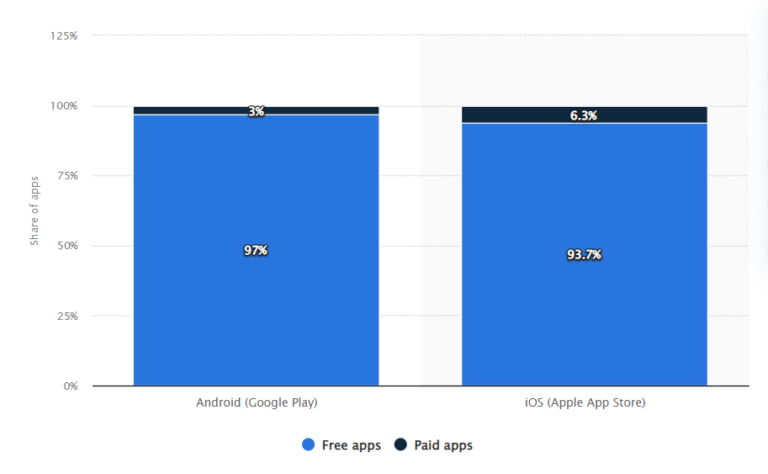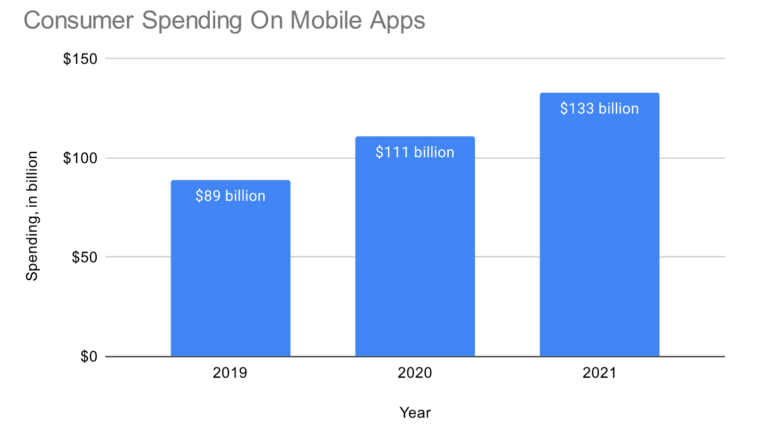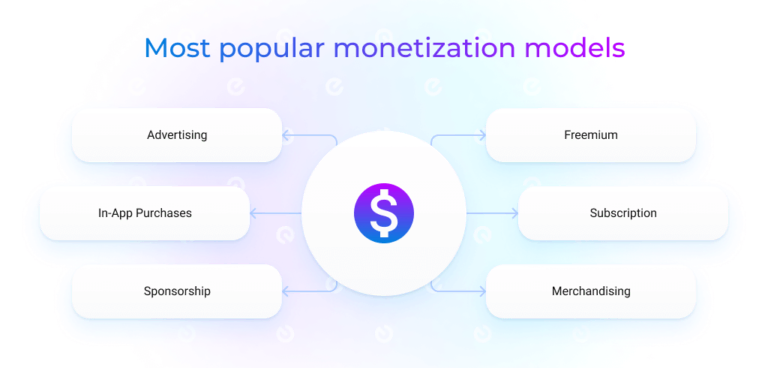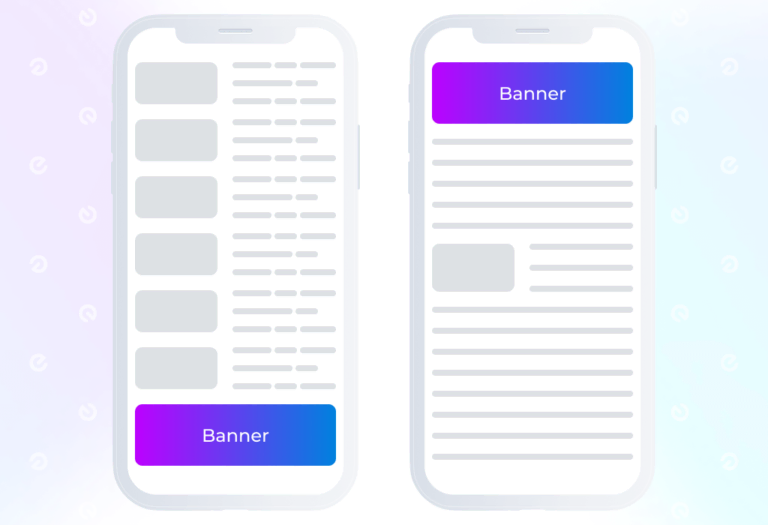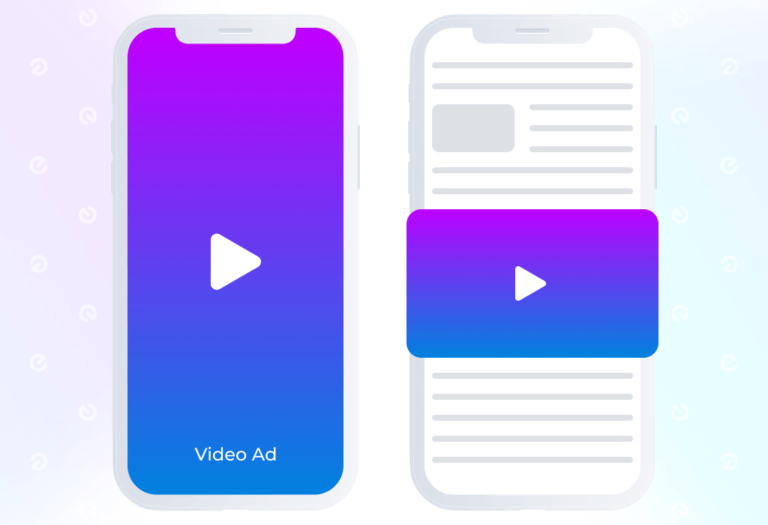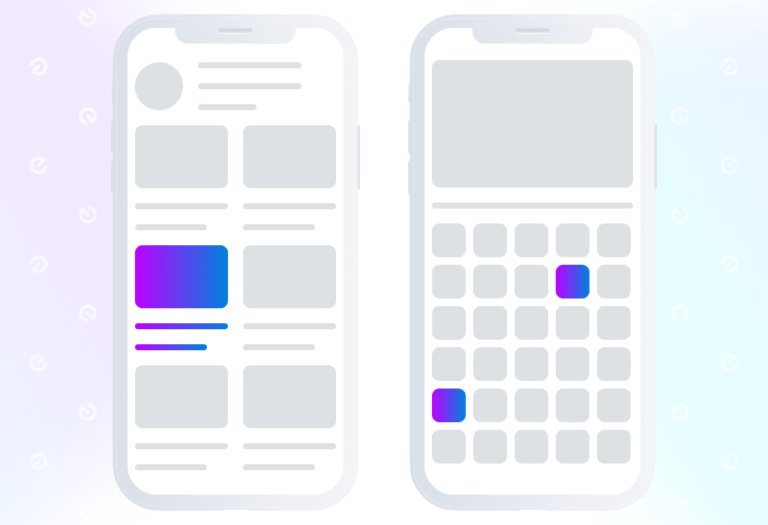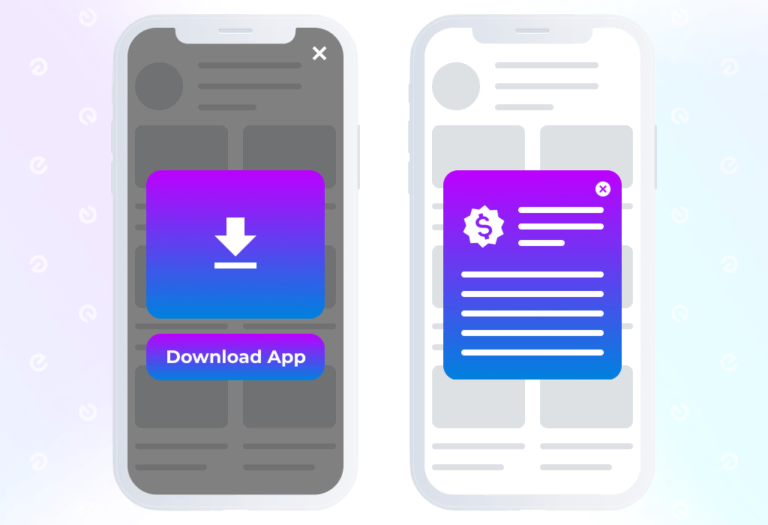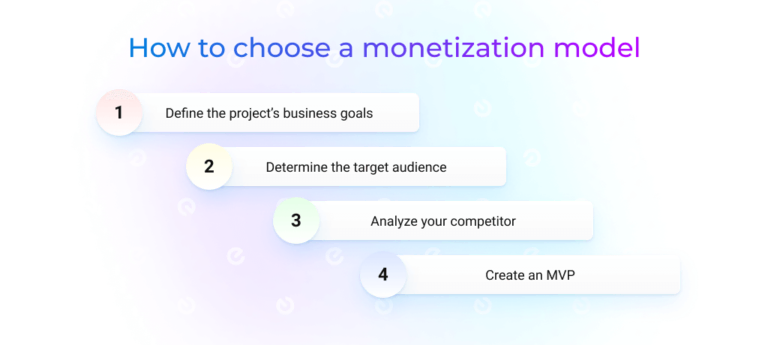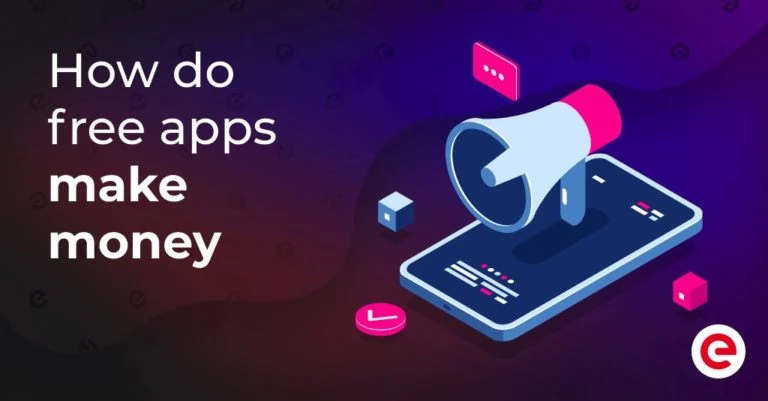
February 23, 2022
How do free apps make money? It is important to know the answer to this question because free mobile applications dominate the software market. Paid apps aren’t in high demand. So, building a free app would be the best option if you want to attract wide audience. Still, receiving income from an app is one of the main goals of software developers. In this article, you’ll find the most effective ways to monetize a free app. We’ll also provide some tips on choosing the best monetization strategy.
List of the Content
- How much money do free apps earn
- How to monetize a free app
- How to choose the best monetization approach
- In conclusion
How many times have you paid for an app from Google Play or App Store? Usually, the applications you download are predominantly free. But, do you think that developers don’t have the profit from them? On the opposite, free applications often bring more income than those requiring initial payments. In this article, we’ll discuss different ways of monetization and answer the question of “How do free apps make money?”
Let’s illustrate our statement about paid and free apps’ share with this Statista research. It shows that on Google Play, only 3% of apps are paid, and the 97% left are free. On App Store, 92% of apps don’t require initial payments.
Interestingly, about 4 months before this statistic was formed, the average number of free Android apps was only 78%. It demonstrates that the app industry tends to satisfy people’s needs and leans towards free applications.
The Business Of Apps presents the research that shows that the yearly revenue of the mobile app industry constitutes $111 billion, distributed between the App Store with the gain of $72.3 billion and Google Play with the income of $38.6 billion. Moreover, recent studies show that the revenue of the mobile app industry will reach $407.3 billion in 2026.
Combining the percentage of free apps and the app industry income, we can predict that free applications are often monetized and bring pretty high revenues to the development companies.
In the previous paragraph, we’ve focused more on the popularity of free mobile apps. Still, we cannot ignore that paid apps are also quite beneficial for software developers. Year by year, the amount of money spent on paid apps increases. For example, in 2021, global consumer spending reached $133 billion, while in 2020, this number was almost 20% less and constituted $111 billion. In 2019, the users’ spendings were even less – only $89 billion globally.
However, along with the increased spending, the overall amount of apps significantly increases as well. Moreover, the ratio between free and paid apps remains the same. As we’ve mentioned, only 3-9% of applications require payments at the download stage.
So, if you’ve wondered if building a paid mobile app is more beneficial than a free app, keep reading to find out how do free apps make money. We’ll look into the most popular monetization strategies and provide tips on choosing the free app monetization model suitable for your project.
Before proceeding to the revenue streams, let’s discuss how much money you can earn from a free mobile application.
HOW MUCH MONEY DO FREE APPS EARN
It wouldn’t be wise to focus on the apps of tech giants while estimating the potential profit from them. We’ll receive unrealistic numbers for startups and even for middle-sized companies if we do so. Fortnite, for example, generated $1.8 billion in 2019. But such numbers are inapplicable for those who start from scratch. So, we won’t claim that free app monetization will bring you a fortune, but it’s still worth making one step at a time to achieve impressive results.
On average, only about 15-25% of top free apps receive income. So, the first rule to follow while building a free app to monetize it is to prioritize high quality over the desire to make money from it as soon as possible.
Let’s see what revenue 20% of the top free apps can expect. There are no accurate numbers, but approximately, a free application with a moderate amount of users can bring you about $5k monthly.
You may want to know what comprises this number. According to the statistics discussed later in the article, advertising is the most popular way to monetize a free app. Advertising implies different methods, such as CPC, CPM, CPV, etc. The average revenue per mile (income from 1000 impressions) in the case of Cost-Per-Impression constitutes about $1.5-$2.
Considering these numbers, you can estimate the number of potential users and receive the approximate income.
Of course, you may choose another monetization method rather than advertising, but we’ve provided it as an example due to its popularity among app developers.
Speaking of other free app monetization models, let’s see how do free apps make money in different ways.
HOW TO MONETIZE A FREE APP
We’ve already mentioned advertising along with the CPC, CPM, and other techniques. But how do free apps make money in different ways? The most popular options are:
-
Advertising
-
Freemium
-
Sponsorship
-
In-App Purchases
-
Subscription
-
Crowdfunding
-
Merchandizing
In the following paragraphs, we will discuss each option and discover its pros and cons.
Take a look at the Business Of Apps’ research on the app monetization models. It proves that those strategies we’ve pointed out are most commonly used and bring guaranteed results.
Advertising
Advertising is the first thing that comes to mind while figuring out how do free apps make money. We constantly see ads no matter what we’re doing – scrolling through a web page or using a mobile application. These ads can be presented in many ways, such as banners, videos, in-built ads, and others. No wonder this option is so popular among software developers. Besides, people are used to it, proving that this way to make money from a free app works.
The core principle of ads is selling space inside your app so that a third-party company can place its commercials there. As we’ve mentioned before, ads can be presented as:
-
Banner ads
-
Video ads
-
Native ads
-
Interstitial ads
Each type of ad looks different and brings different income. For example, the views of video advertisements cost much more than the ones of banner ads. Let’s look at each option in more detail and figure out the most efficient strategy to make money from a free app.
Banner ads. Banner ads are usually placed on the top or bottom of the app. They don’t overlap the content of an app, so they allow users to use software without being distracted by commercials.
On the one hand, it is the most comfortable option from the users’ point of view. However, it is also a less-paid option. Apart from the fact that the average CPC is about $0.50, users won’t click on banners often enough to bring considerable revenue to the software provider.
Video ads. The following answer to “How do free apps make money” is videos. They usually last from 10 to 30 seconds. They appear over the application content when the flow of the app is naturally paused. For example, when a user has finished doing some action, such as editing a photo.
Usually, a user can close the video after a few seconds. Besides, rewarded videos are an excellent option for both software providers and users. Firstly, they bring higher revenue, and secondly, they reward users for watching a video with some extra points, money, or other possibilities depending on the app type. Still, this option is the most suitable for apps where people spend much time, such as games or social media. By the way, videos are the most paid type of ads. On average, the CPM in the case of video ads constitutes from $5 to $10.
Native ads. Native ads are integrated as a part of the natural user interface. For example, let’s take an app that contains a list of buttons that extend over the entire width of the screen. In this case, a native advertisement will look precisely like another button of the same shape but with the text or picture of the promoted product.
Native commercials have a significant advantage over the other ad types – they are recognized as the less irritative and distracting adverts.
However, the situation resembles banners – they don’t disturb users but bring relatively low income. The CPM of a native ad is about $0.70, which is only a bit higher than the CPM of banners.
Still, considering the unobtrusiveness of such ads, a software provider can make it appear more often than videos, and it will probably still be seamless for the users.
Interstitial ads. Interstitial advertisements are pop-ups that appear at specific time frames and hover over the whole screen. Then, the user can close it or take the promoted action – proceed to the website or install an application.
Such ads are rather distractive, so software devs should be cautious about them and set such timeframes so that users won’t abandon the app because of irritating advertisements. Besides, the CPM for interstitial ads is moderate and varies between $1 to $4, so there’s no necessity to run them too often.
We’ve repeatedly mentioned the notion of CPM but haven’t clearly defined it. It is one of the affiliate marketing methods, along with the CPC and CPA.
CPM is Cost-Per-Impression (how many times the audience has seen the ad).
CPC is Cost-Per-Click (how many times people clicked an ad).
CPA is Cost-Per-Action (how many times users performed the promoted action, such as installed an app or shared the content).
Each of these models can be used to make money from a free app. Although, they require third-party providers to be promoted within your software.
These models differ in price. CPM is less paid for because the users have seen the ad doesn’t mean that they will interact with it in the future. CPC is more valuable because it means higher user engagement. CPA is the most paid method in affiliate marketing because it leads to the highest user retention rate.
Usually, when someone places an ad in their app, the CPM, CPC, and CPA are determined beforehand, so the app vendor knows what to expect.
Consider combining some of them if you’re hesitating about what free app monetization model to choose. Advertising is the winning option because it will satisfy different types of users. For example, integrate some native ads along with the video ads and even add some banners.
Freemium
Freemium is the second most popular answer to “How do free apps make money.” This monetization model results in a relatively high user retention rate. It may work in two ways:
-
Users receive access to a limited amount of features, and they may pay if they want to upgrade their accounts to access the premium app features.
-
Users receive full access to an app, and sometime later, they may pay to continue using the app or keep using its free version, but without the premium features.
Both ways work well, but the first one is more commonly used because people will most likely pay if they can get additional features rather than if they suddenly get restricted access.
The absence of intrusive ads is among the most significant advantages of a freemium model.
Freemium is the winning option to monetize a free app if you suggest that the app idea will be interesting for users and they would like to pay and keep using the app.
This is not an excellent strategy for games, for example. However, it is perfect for productivity and education apps.
Sponsorship
The sponsorship model distantly reminds the advertising model because it implies product placement within an app. The difference between these two methods to monetize a free app is that sponsorship means the collaboration with the one exact partner, while advertising means integrating ads of various companies. Another thing that differentiates sponsorship is that it advertises only relatable products.
For example, if you’ve built a fitness app and would like to use the sponsorship monetization method, it won’t be right to advertise cars, but it’s reasonable to place the ad of a healthy nutrition brand.
Sponsorship is also an answer to “How do free apps make money,” but it’s suitable for a small range of apps, and its success depends on several factors. However, used correctly, it can bring considerable benefits to your business.
In-App Purchases
In-app purchases are often included in the freemium model. This approach allows users to buy some consumable or non-consumable goods. For example, health points or extra money would be perfect for gaming apps, and ad-blocking is highly suitable for productivity apps.
This way to monetize a free app used to be the most popular one for years. Today, it is inferior to advertising and freemium. However, it is still beneficial for numerous kinds of apps.
Since with in-app purchases, you can offer various types of goods, you can implement this strategy to monetize a free app almost in any software.
Subscription
Subscription is not among the most popular ways to monetize a free app. However, for some types of applications, it is highly suitable. This monetization model implies that a user is charged a fee for a particular time. Subscriptions can require weekly, monthly, or yearly payments.
Of course, it is essential to consider the target audience. For example, gamers most likely won’t be enthusiastic about this approach. However, if we’re talking about a video or audio streaming service, newsletter, or business app, the subscription model is an excellent way to monetize a free app.
People often avoid apps with subscriptions because they don’t know if they would like the application, and therefore, they don’t want to pay for it in advance. In this case, a free period would be a great solution. Apple Music, Netflix, and Spotify provide the possibility to try the app for free for a few months, and then, people may subscribe if they have found the product helpful.
Merchandising
The last but not least answer to “How do free apps make money” is selling merchandise. This option is not suitable for most apps, but it is still highly effective in some cases. So, let’s see what it is.
Merchandizing means that you create physical products with the paraphernalia of your product. For example, if you’ve made a game where the main character is a dog, merchandizing would mean that you’ll create T-shirts, backpacks, or cups with this dog and sell them to people.
Speaking of platforms, the Amazon Merch tool provides a platform for selling merchandise. It takes care of payments, shipments, delivery, etc.
The main challenge with selling merchandise is that this strategy will succeed if your app already has a large audience and takes the top charts in the software market. When you’ve reached the point where people recognize your brand, think of implementing merchandising to monetize your free app.
Want to know more about monetization strategies?
We’ve covered such topics as the importance of choosing the appropriate monetization strategy, figured out the objectives and types of the strategies, and provided some tips on determining the best approach.
HOW DO FREE APPS MAKE MONEY: CHOOSING THE BEST APPROACH
As we’ve figured out, there are numerous ways to monetize a free app. Some of them are more popular than others. However, the most commonly used strategy may not be the best choice precisely for your project. You should choose the approach according to some different factors. Let’s see what things you should consider while choosing a way to monetize your app.
Define The Project’s Business Goal
Before proceeding to the development itself, it’s crucial to unequivocally define what goals you want to achieve by creating an application.
Do you want to generate quick income without spending too much time attracting a large audience? In this case, advertising would be the most suitable option as it brings revenue independently of the app’s popularity.
Are you focused on building brand recognition from scratch and attracting as many users as possible? A paid subscription or trial period won’t help you achieve this goal. Consider starting with strategies that don’t involve high user investments, such as in-app purchases or sponsorship.
Are you creating an app for an existing business? This is a perfect opportunity to use the freemium model or paid subscription. As people are already familiar with the brand, they will be ready to invest some money in a product.
Find The Target Audience
The next step – defining the target audience, derives from the previous paragraph. When you know what services you deliver, you know what type of people are looking for them.
Knowing the target audience includes analyzing their needs, approximate age, paying ability, etc. So, when you’re discovering what people are going to use your product, you want to figure out whether they will be able to pay for the app or not. For example, subscriptions always imply regular payments. Sometimes it’s a couple of dollars, and sometimes it’s about a hundred. So, if you know that teenagers will use the app, you should cross the freemium and subscription models off the list.
If we’re talking about the free app monetization models that don’t require payments, it’s still worth considering the potential users. Suppose you want to implement the advertising model in your app. What types of ads to choose? Consider that those using a planning app, for example, won’t wait until the 30-second video finishes, and they’re likely to abandon the app. However, such an option is perfect for gamers that will receive rewards for watching video ads.
Well, you’ve got the idea: people’s age, patience, and paying ability can help you decide what strategy for monetizing a free app you should choose.
Analyze Your Competitors
If you’ve found out a lot about free app monetization models, considered the business goals and target audience, and still can’t decide on the appropriate strategy, analyze your competitors. Other software companies have most likely built something similar to your app. And if you see that their approach has brought expected results, such as user retention and high download rates, you can learn from them.
Firstly, you need to determine what category your app relates to and its core features. When you do that, find the apps resembling yours by these criteria, and look at what monetization models they leverage.
Create An MVP
After you’ve chosen the free app monetization strategy that best suits your project, it’s time to proceed to development. However, it’s worth starting with an MVP and not a full-fledged product.
When you launch an MVP, you have enough time to understand whether people like your app, and their feedback helps you find the weak spots and improve the existing functionality. MVP is especially useful if we’re talking about app monetization. Choosing the best approach may not be an easy task, so it’s essential to try it on real users and see what result it brings. In addition, an MVP is an excellent way to save some budget and time.
Want to know more about MVP development?
In the article, we’ve discussed the pros and cons of creating an MVP and provided a step-by-step guide to creating a minimum viable product.
CONCLUSION
Well, we’ve discussed the most popular answers to “How do free apps make money?” With all the information presented in the article, you can choose a suitable monetization model for your project. Remember that the most popular approaches are not always the best ones. To select the best strategy, it’s necessary to consider such factors as the target audience and the application’s business goal.
Have additional questions on how do free apps make money?
At EXISTEK, we have extensive experience in monetizing free applications. We’ve worked with startups and enterprises, and we know how to choose the best monetization approach that will benefit your business. Need our help in selecting the monetization strategy or developing a new project? Get in touch with our specialists.
Frequently asked questions
How much money do free apps earn?
The amount of money a free application can bring heavily depends on the number of users. Most apps use advertising as their main monetization strategy. In this case, you can count your income according to the CPM model, which brings $1.5-$2 per 1000 ad views. If you can't estimate the number of users, we can say that the average income of a free app constitutes about $5k monthly.
How do free apps without ads make money?
Advertising is the most popular monetization strategy, However, not all apps implement it for various reasons. If the app doesn't include ads, it can make money via providing the freemium model, in-app purchases, subscriptions, or merchandising.
How to choose a monetization strategy?
The most important aspect in choosing the monetization strategy is defining the target audience. Depending on the type of users, you can decide whether regular payments would be suitable, or it's better to use ads that don't require actual payments from people. So, defining the app's business goal and target audience, and analyzing the competitors would be the right steps to choose the best monetization approach.

